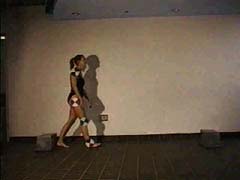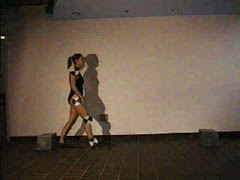|
|
|
|
See video (requires Netscape 3.0 and Quicktime 2.5) | |
INTRODUCTION
In preparation for engaging in certain types of water activities such as snorkeling, it is customary to don swimming flippers to facilitate movement while in the water. Participants in these activities don swimming flippers prior to entering the water because they believe it will be easier to make adjustments to and become familiar with the flippers while on land. Many participants of water activities believe that walking in flippers will be much like walking in bare feet and are astonished to find that acquainting oneself with "flipper" gait can lead to difficulty with the gait cycle. What differences, if any, occur in the gait of an individual walking in bare feet and walking in swimming flippers? We believe that some problems encountered during the gait cycle are due to the participant's unfamiliarity with the oversized flipper and the fact that the flipper creates an obstacle for the participant resulting in loss of balance. The water sports enthusiast may or may not be aware of the presence of this obstacle, depending on other distractions such as lighting, distractions an/or attention and the potential hazards from a resulting loss of balance. We believe that attention to the task at hand coupled with effective compensation techniques would assist the water sports enthusiast in maintaining upright balance when walking in swimming flippers (Chen et al., 1991).
The purpose of our study is to observe, analyze and compare the biomechanical differences that result in the upper leg segment, knee joint and ankle joint when walking in bare feet and in swimming flippers on dry ground in order to provide a working knowledge of "flipper" gait for water sports enthusiasts. Patla and Prentice (1995) observed a relationship between overcoming obstacles and joint motion at the hip and knee. In this study, swimming flippers present the obstacle for which the body must compensate in order to maintain balance and upright forward motion. We believe that walking in swimming flippers will require a greater range of motion at the hip and knee as well as a longer, slower stride length in order to prevent tripping. This study examines the kinematics of bare foot gait and flipper gait by conducting a digital analysis of motion at the hip, knee and ankle joints for both barefoot walking and flipper walking in a quest for the answer.

